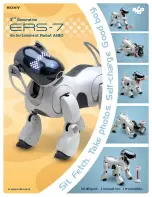
Programming manual for Meca500 (for firmware 9.2.x)
17
TCP/IP COMMUNICATION
GetRtGripperState
). If, somehow, the object is removed, the fingers will then move to the desired
fingers opening. Recall that you can reduce the grip force with the
SetGripperForce
command. In
addition, you can control the speed of the gripper with the
SetGripperVel
command.
The
MoveGripper
command behaves like a motion command, and will be executed only after the
preceding motion command has been completed. However, if a robot motion command is sent
after this command, the robot will start executing the motion command without waiting for the
gripper to finish its action. You must therefore send a
Delay
command after the
MoveGripper
command.
2.1.4 MoveJoints(
θ
1
,
θ
2
,
θ
3
,
θ
4
,
θ
5
,
θ
6
)
This command makes the robot simultaneously rotate all Its joints to the specified joint set. The robot
takes a linear path in the joint space, but nonlinear in the Cartesian space. Therefore, the TCP trajectory
is not easily predictable (
). Finally, with
MoveJoints
, the robot can cross singularities without
any problem.
Arguments
•
θ
i
: the (admissible) angle of joint
i
(
i
= 1, 2, ..., 6), in degrees. The admissible default ranges for the
joint angles are as follows:
−175° ≤
θ
1
≤ 175°,
−70° ≤
θ
2
≤ 90°,
−135° ≤
θ
3
≤ 70°,
−170° ≤
θ
4
≤ 170°,
−115° ≤
θ
5
≤ 115°,
−36,000° ≤
θ
6
≤ 36,000°.
These ranges can be further limited with the command
SetJointLimits
.
Figure 12: End-effector motion when using the
MoveJoints
or
MovePose
commands
2.1.5 MoveJointsRel(
Δ
θ
1
,Δ
θ
2
,Δ
θ
3
,Δ
θ
4
,Δ
θ
5
,Δ
θ
6
)
This command has the exact behavior as the
MoveJoints
command, but instead of accepting the
desired (target) joint set as arguments, it takes the desired relative joint displacements. The command is
Summary of Contents for Meca500 R3
Page 10: ......
















































